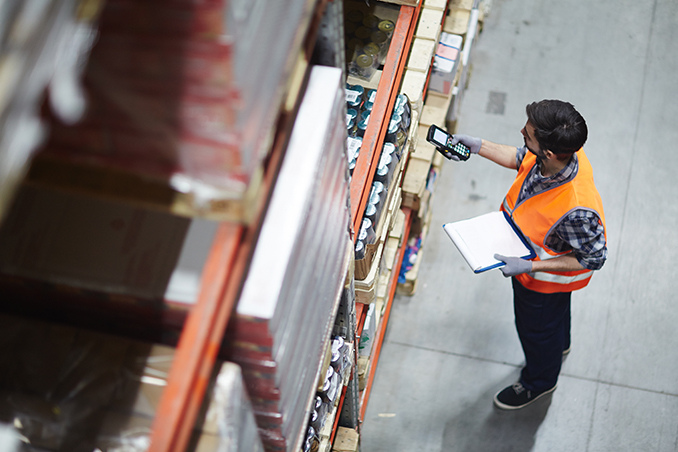AGVs in production supply
Read more

RFID (Radio Frequency Identification) is often mentioned in connection with Industry 4.0. But what exactly is RFID and for which processes is it useful in logistics centers or generally in a warehouse with SAP Extended Warehouse Management (SAP EWM)?
RFID refers to a technology for localization and automatic identification by radio waves. The application of the technology requires a system of transmitter and receiver, which consists of a transponder and a reader. The readers can be mostly mobile devices, but also stationary units.
The use of RFID-supported processes is a rarely used technology in warehouse logistics with SAP EWM. In principle, however, it can be used for many application areas. Whether the use is advantageous depends entirely on the circumstances. In the following, we will take a closer look at possible application examples and show to what extent RFID technologies set new standards for warehouse optimization.
Implementing advanced RFID technology creates a sophisticated network that takes warehouse optimization to a new level. The now affordable transponders make this technology particularly attractive, meaning that some manual interventions will be a thing of the past in the future thanks to RFID. Thanks to automated order distribution to different handheld devices, work management becomes more flexible, opening up new efficiency potential and significantly reducing the risk of loss of goods. The ability to use real-time data leads to lightning-fast and automatic reactions to a wide variety of conditions in the warehouse. For example, the system automatically detects when a particular warehouse zone is heavily congested and then directs available personnel to the exact location to eliminate bottlenecks and maintain smooth operations. This level of automation and flexibility leads to greater efficiency and, ultimately, a significant increase in performance in various areas of the supply chain.
In goods receiving, the strengths of RFID are evident in the form of increased efficiency. Here, load carriers can be processed in bulk without the need for employees to perform any additional activities (recording or scanning). Supported by an easily visible monitor or a terminal on the forklift, the user can check his incoming goods. Load carriers not posted in SAP EWM can be visualized in these displays and processed after unloading. If the goods receipt is performed individually for each load carrier (e.g. pallets are unloaded from a truck one by one) an automatic putaway into the quality assurance or free stock is possible. Also, the goods can be stored immediately in the final destination storage bin. The respective destination is displayed to the employees at the terminal. After the goods have been placed into storage, the storage task (ST) is confirmed via touchscreen in SAP EWM.
For mass processing of load carriers, the readings are processed in SAP EWM via an inbound queue. This ensures that no readings remain unprocessed. On the hardware side (RFID reading technology), attention must be paid to the so-called read rate. Above a certain number of simultaneous reads, the error frequency (depending on the reading technology) can increase significantly, which reduces the effectiveness of the overall solution, as manual rework becomes necessary in the SAP system. However, with high-quality reading technology and good reading rates, a noticeable gain in efficiency can be achieved very quickly.
In manual warehouses, the storage and retrieval of goods can be performed by mobile MDE devices (handheld scanners) with integrated RFID readers. The risk of unwanted readings must be kept as low as possible in this application. By aligning the receiver antenna, it is possible to adapt the reading range to the respective requirements. Depending on the model, the alignment of the reading range can be set in the software or is solved by means of appropriate signage.
A subsequent check of the recorded TAG number is usually not useful. The time required compared to barcode recording is negligible, which makes the application interesting only for niche products (e.g. very large components).
For packing stations/packing tables, the manual scan of a barcode can be replaced by an RFID capture in SAP EWM. The prerequisite is a well-structured and clear workstation dialog (in SAP EWM) that shows employees the respective work steps and guides them through the process. If this technology is additionally supported by a touch screen, input devices can be completely dispensed with. This usually leads to a significant optimization of the packaging process (gain in time and efficiency).
In goods issue, the situation is similar to that in goods receipt: Here, load carriers can also be processed in bulk and posted as GI. As in goods receiving, it makes sense to provide a monitor or terminal that can be easily seen to check all readings on the stacker. Here, employees can see at a glance load carriers that have not been booked.
In practice, RFID applications are nowadays additionally supplemented by barcode labeling or other (alternative) handling processes in order to ensure complete process reliability, despite many advantages. One often has to consider the flexibility as well as the cost factor of the reading technology. In principle, RFID cannot yet be used as flexibly as goods identification with barcodes (barcodes are still the market standard).
If RFID labels are used, they must be created with a special printer, which drives up the cost factor even further in addition to the hardware costs for the reading technology. Keeping the cost-benefit factor in mind, RFID can be very useful in the medium and long term, especially for automatic bookings in incoming and outgoing goods.